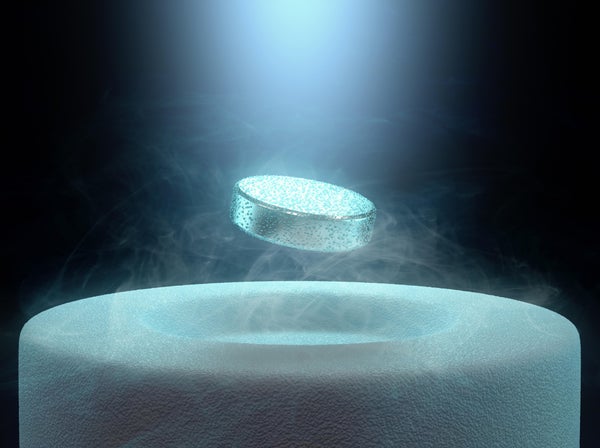Scientists have created a mystery material that seems to conduct electricity without any resistance at temperatures of up to about 15 °C. That’s a new record for superconductivity, a phenomenon usually associated with very cold temperatures. The material itself is poorly understood, but it shows the potential of a class of superconductors discovered in 2015.
The superconductor has one serious limitation, however: it survives only under extremely high pressures, approaching those at the centre of Earth, meaning that it will not have any immediate practical applications. Still, physicists hope it could pave the way for the development of zero-resistance materials that can function at lower pressures.
Superconductors have a number of technological applications, from magnetic resonance imaging machines to mobile-phone towers, and researchers are beginning to experiment with them in high-performance generators for wind turbines. But their usefulness is still limited by the need for bulky cryogenics. Common superconductors work at atmospheric pressures, but only if they are kept very cold. Even the most sophisticated ones—copper oxide-based ceramic materials—work only below 133 kelvin (−140 °C). Superconductors that work at room temperature could have a big technological impact, for example in electronics that run faster without overheating.
On supporting science journalism
If you're enjoying this article, consider supporting our award-winning journalism by subscribing. By purchasing a subscription you are helping to ensure the future of impactful stories about the discoveries and ideas shaping our world today.
The latest study, published in Nature on 14 October, seems to provide convincing evidence of high-temperature conductivity, says physicist Mikhail Eremets at the Max Planck Institute for Chemistry in Mainz, Germany—although he adds that he would like to see more “raw data” from the experiment. He adds that it vindicates a line of work that he started in 2015, when his group reported the first high-pressure, high-temperature superconductor—a compound of hydrogen and sulfur that had zero resistance up to −70 °C.
In 2018, a high-pressure compound of hydrogen and lanthanum was shown to be superconductive at −13 °C. But the latest result marks the first time this kind of superconductivity has been seen in a compound of three elements rather than two—the material is made of carbon, sulfur and hydrogen. Adding a third element greatly broadens the combinations that can be included in future experiments searching for new superconductors, says study co-author Ashkan Salamat, a physicist at the University of Nevada, Las Vegas. “We’ve opened a whole new region” of exploration, he says.
Materials that superconduct at high but not extreme pressures could already be put to use, says Maddury Somayazulu, a high-pressure-materials scientist at Argonne National Laboratory in Lemont, Illinois. The study shows that by “judiciously choosing the third and fourth element” in a superconductor, he says, you could in principle bring down its operational pressure.
The work also validates decades-old predictions by theoretical physicist Neil Ashcroft at Cornell University in Ithaca, New York, that hydrogen-rich materials might superconduct at temperatures much higher than was thought possible. “I think there were very few people outside of the high-pressure community who took him seriously,” Somayazulu says.
Mystery material
Physicist Ranga Dias at the University of Rochester in New York, along with Salamat and other collaborators, placed a mixture of carbon, hydrogen and sulfur in a microscopic niche they had carved between the tips of two diamonds. They then triggered chemical reactions in the sample with laser light, and watched as a crystal formed. As they lowered the experimental temperature, resistance to a current passed through the material dropped to zero, indicating that the sample had become superconductive. Then they increased the pressure, and found that this transition occurred at higher and higher temperatures. Their best result was a transition temperature of 287.7 kelvin at 267 gigapascals—2.6 million times atmospheric pressure at sea level.
The researchers also found some evidence that the crystal expelled its magnetic field at the transition temperature, a crucial test of superconductivity. But much about the material remains unknown, researchers warn. “There are a lot of things to do,” says Eremets. Even the crystal’s exact structure and chemical formula are not yet understood. “As you go to higher pressures, the sample size gets smaller,” says Salamat. “That’s what makes these types of measurements really challenging.”
High-pressure superconductors made of hydrogen and one other element are well understood. And researchers have made computer simulations of high-pressure mixtures of carbon, hydrogen and sulfur, says Eva Zurek, a computational chemist at the State University of New York at Buffalo. But she says those studies cannot explain the exceptionally high superconducting temperatures seen by Dias’s group. “I am sure, after this manuscript is published, many theoretical and experimental groups will jump on this problem,” she says.
This article is reproduced with permission and was first published on October 14 2020.
